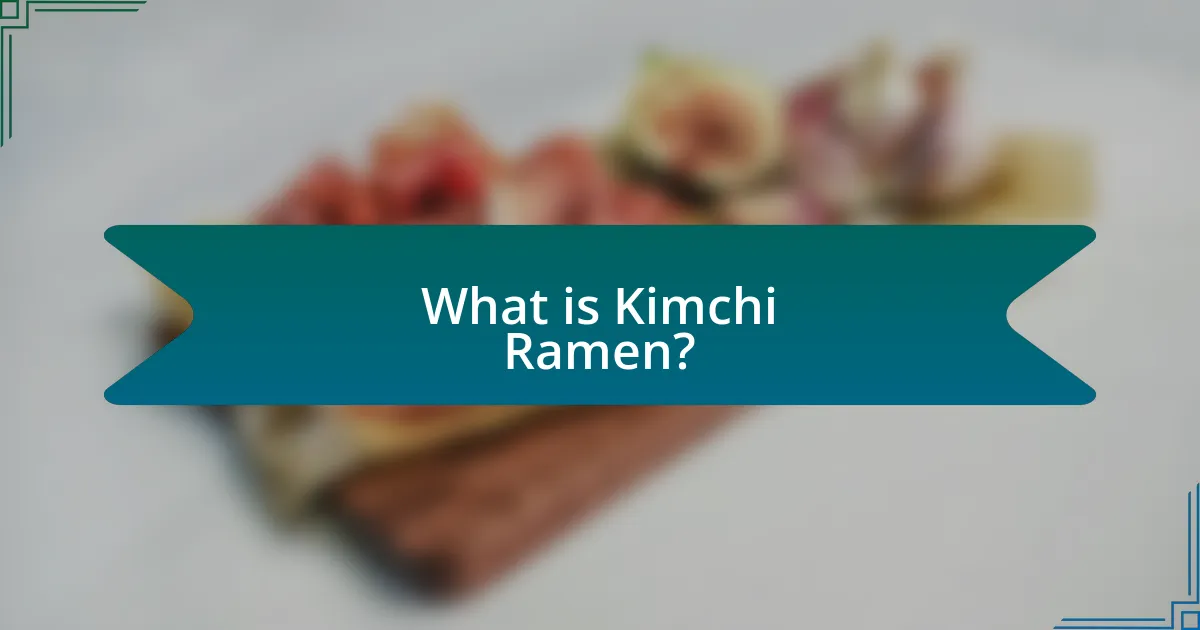Kimchi Ramen is a popular fusion dish that combines traditional Japanese ramen with Korean kimchi, resulting in a flavorful and nutritious meal. Originating in South Korea during the late 20th century, this dish reflects the blending of Korean and Japanese culinary influences, characterized by its spicy and tangy broth enriched with probiotics from kimchi. The article explores the origins, cultural significance, key ingredients, preparation methods, and variations of Kimchi Ramen, as well as its nutritional benefits and the emotional connections people have with this comfort food. Additionally, it addresses common misconceptions, the impact of food trends, and tips for enhancing the Kimchi Ramen experience.

What is Kimchi Ramen?
Kimchi Ramen is a flavorful noodle dish that combines traditional ramen with kimchi, a fermented Korean vegetable side dish, typically made from napa cabbage and seasoned with chili pepper, garlic, and ginger. This fusion creates a spicy and tangy broth that enhances the umami flavor of the ramen noodles. The incorporation of kimchi not only adds depth to the dish but also provides probiotics, which are beneficial for gut health. Kimchi Ramen has gained popularity in various culinary scenes, reflecting the growing trend of blending different cultural cuisines.
How did Kimchi Ramen originate?
Kimchi Ramen originated as a fusion dish that combines traditional Korean kimchi with Japanese ramen. This culinary innovation emerged in South Korea during the late 20th century, reflecting the growing popularity of both Korean and Japanese cuisines. The incorporation of kimchi into ramen not only enhances the flavor profile with its spicy and tangy notes but also adds nutritional value, making it a beloved comfort food in both countries. The dish gained international recognition as Korean cuisine became more mainstream, particularly through the global spread of Korean pop culture and food trends.
What cultural influences shaped Kimchi Ramen?
Kimchi Ramen is shaped by Korean and Japanese culinary influences. The incorporation of kimchi, a staple in Korean cuisine known for its fermented vegetables and bold flavors, reflects the Korean influence. Meanwhile, the ramen noodles and broth are derived from Japanese culinary traditions, which emphasize umami and rich flavors. This fusion creates a dish that combines the spiciness and tanginess of kimchi with the comforting, savory elements of traditional ramen, illustrating the blending of these two distinct cultures in a single bowl.
How has Kimchi Ramen evolved over time?
Kimchi Ramen has evolved from a traditional Korean dish into a popular fusion food that combines elements of Korean and Japanese cuisine. Initially, kimchi was primarily served as a side dish in Korea, while ramen originated in Japan as a noodle soup. The fusion began in the late 20th century when chefs started incorporating kimchi into ramen, enhancing the flavor profile with its spicy and tangy notes. This evolution gained momentum in the 2000s, particularly in urban areas with diverse culinary scenes, leading to the widespread availability of kimchi ramen in restaurants and instant noodle varieties. The growing popularity of Korean cuisine globally has further solidified kimchi ramen’s status as a beloved comfort food, reflecting a blend of cultural influences and culinary innovation.
What are the key ingredients in Kimchi Ramen?
The key ingredients in Kimchi Ramen include ramen noodles, kimchi, broth (typically made from chicken or pork), green onions, and a protein such as tofu or pork. Ramen noodles serve as the base, while kimchi adds a spicy and tangy flavor. The broth provides depth, and green onions contribute freshness. Tofu or pork enhances the dish’s protein content, making it a balanced meal.
What types of kimchi are commonly used?
Commonly used types of kimchi include Napa cabbage kimchi, radish kimchi, and cucumber kimchi. Napa cabbage kimchi, known as “baechu kimchi,” is the most popular variety, often fermented with a mixture of chili pepper, garlic, and ginger. Radish kimchi, or “kkakdugi,” consists of diced radish and is typically served as a side dish. Cucumber kimchi, referred to as “oi sobagi,” is made with cucumbers and is usually prepared for a refreshing taste. These varieties are integral to Korean cuisine and are frequently used in dishes like kimchi ramen, enhancing flavor and nutritional value.
How do different noodles affect the dish?
Different noodles significantly affect the dish by altering its texture, flavor absorption, and overall mouthfeel. For instance, ramen noodles, which are typically made from wheat and have a chewy texture, enhance the dish’s heartiness and allow for better absorption of the broth’s flavors. In contrast, rice noodles, which are softer and more delicate, may result in a lighter dish that emphasizes the freshness of the kimchi rather than the richness of the broth. Additionally, the thickness of the noodles can influence the dish’s presentation and how well the ingredients cling to them, impacting the overall eating experience.
What makes Kimchi Ramen a comfort food?
Kimchi Ramen is considered a comfort food primarily due to its rich flavors and satisfying texture. The combination of spicy, tangy kimchi with hearty noodles creates a warm and fulfilling dish that evokes feelings of nostalgia and satisfaction. Additionally, the fermentation in kimchi provides probiotics, which can enhance gut health, further contributing to the overall comfort experience. The dish’s ability to be easily customized with various toppings, such as eggs or vegetables, allows for personal preference, making it a versatile option that resonates with many individuals seeking comfort in their meals.
How does the flavor profile contribute to its comfort food status?
The flavor profile of kimchi ramen significantly contributes to its comfort food status by combining rich umami, spiciness, and tanginess. This blend of flavors evokes warmth and satisfaction, often associated with traditional comfort foods. The umami from the broth, enhanced by fermented kimchi, creates a deep, savory taste that is both nourishing and fulfilling. Additionally, the spiciness from the kimchi stimulates the palate, while the tanginess adds a refreshing contrast, making the dish enjoyable and comforting. Studies show that comfort foods often feature familiar and satisfying flavors, which is precisely what kimchi ramen offers, reinforcing its status as a beloved comfort food.
What emotional connections do people have with Kimchi Ramen?
People have strong emotional connections with Kimchi Ramen due to its association with comfort, nostalgia, and cultural identity. This dish often evokes memories of family gatherings and shared meals, particularly in Korean culture, where it is commonly enjoyed. The spicy and savory flavors of Kimchi Ramen can trigger feelings of warmth and satisfaction, reinforcing its role as a comfort food. Additionally, the fusion aspect of Kimchi Ramen allows individuals to connect with diverse culinary traditions, enhancing their appreciation for multicultural experiences.

How is Kimchi Ramen prepared?
Kimchi Ramen is prepared by first cooking instant ramen noodles according to package instructions, typically boiling them in water for about 3-4 minutes. After the noodles are cooked, they are drained and set aside. In a separate pot, a broth is made by combining water, kimchi, and seasonings such as gochujang (Korean chili paste) and soy sauce, simmering for several minutes to enhance the flavors. The cooked noodles are then added to the broth, and the dish is often garnished with toppings like sliced green onions, a boiled egg, and additional kimchi. This method combines traditional ramen preparation with the distinct flavors of kimchi, creating a unique fusion dish.
What are the basic steps in making Kimchi Ramen?
To make Kimchi Ramen, start by preparing the broth, which typically involves boiling water and adding instant ramen seasoning or miso paste. Next, cook the ramen noodles according to package instructions until al dente. In a separate pan, sauté kimchi with garlic and ginger to enhance its flavor. Combine the cooked noodles with the broth and the sautéed kimchi, then add toppings such as green onions, a soft-boiled egg, and sesame seeds. This method effectively blends the flavors of traditional ramen with the tangy taste of kimchi, creating a comforting dish.
How do you properly cook the noodles for Kimchi Ramen?
To properly cook the noodles for Kimchi Ramen, bring a pot of water to a rolling boil and add the noodles, cooking them for 3 to 5 minutes until they are al dente. The specific cooking time may vary depending on the type of noodles used, such as instant ramen or fresh noodles, which typically require less time. After cooking, drain the noodles and rinse them briefly under cold water to stop the cooking process and remove excess starch, ensuring a better texture in the final dish.
What techniques enhance the flavor of the broth?
Techniques that enhance the flavor of the broth include simmering, using umami-rich ingredients, and incorporating aromatics. Simmering the broth for an extended period allows flavors to meld and deepen, creating a more complex taste profile. Umami-rich ingredients such as dried mushrooms, seaweed, or fermented products like miso or soy sauce contribute depth and richness to the broth. Additionally, incorporating aromatics like garlic, ginger, and scallions at the beginning of the cooking process infuses the broth with fragrant notes that elevate its overall flavor.
What variations of Kimchi Ramen exist?
Variations of Kimchi Ramen include traditional Kimchi Ramen, Spicy Kimchi Ramen, Kimchi Ramen with Tofu, Kimchi Ramen with Seafood, and Vegan Kimchi Ramen. Traditional Kimchi Ramen features a broth infused with fermented kimchi, while Spicy Kimchi Ramen amplifies the heat with additional chili paste. Kimchi Ramen with Tofu incorporates protein-rich tofu, and Kimchi Ramen with Seafood adds shrimp or fish for a savory twist. Vegan Kimchi Ramen substitutes animal products with plant-based ingredients, catering to dietary preferences. Each variation maintains the core elements of kimchi and ramen while introducing unique flavors and ingredients.
How do regional differences influence Kimchi Ramen recipes?
Regional differences significantly influence Kimchi Ramen recipes by altering the ingredients, preparation methods, and flavor profiles based on local culinary traditions. For instance, in South Korea, Kimchi Ramen often incorporates a variety of fermented kimchi types, which can vary by region, such as Baechu (napa cabbage) kimchi in the Seoul area versus Kkakdugi (cubed radish) kimchi in the countryside. Additionally, regions may emphasize different spices or broths; for example, coastal areas might include seafood-based broths, while inland regions may focus on meat-based options. This diversity reflects the local availability of ingredients and cultural preferences, leading to unique variations of Kimchi Ramen that highlight regional tastes and cooking styles.
What are some popular toppings for Kimchi Ramen?
Popular toppings for Kimchi Ramen include sliced green onions, soft-boiled eggs, nori (seaweed), and sesame seeds. These toppings enhance the flavor and texture of the dish, providing a balance to the spiciness of the kimchi. Additionally, proteins such as sliced pork belly or tofu are commonly added, contributing to the dish’s heartiness and nutritional value.
What are the nutritional aspects of Kimchi Ramen?
Kimchi Ramen is a dish that combines the nutritional benefits of kimchi with the carbohydrate content of ramen noodles. Kimchi, a fermented vegetable dish primarily made from napa cabbage and radishes, is rich in vitamins A, B, and C, as well as probiotics that support gut health. Ramen noodles, typically made from wheat, provide carbohydrates for energy but can be high in sodium and low in fiber. A standard serving of Kimchi Ramen can contain approximately 400-600 calories, depending on the ingredients used, with a balance of protein, fats, and carbohydrates. The inclusion of kimchi enhances the dish’s nutritional profile by adding antioxidants and dietary fiber, which can aid digestion and promote overall health.
How does Kimchi contribute to health benefits?
Kimchi contributes to health benefits primarily through its rich probiotic content, which supports gut health. The fermentation process of kimchi produces beneficial bacteria, such as Lactobacillus, that enhance digestion and improve the balance of gut microbiota. Studies have shown that these probiotics can boost the immune system, reduce inflammation, and may even lower the risk of certain diseases, including obesity and diabetes. Additionally, kimchi is high in vitamins A, B, and C, as well as antioxidants, which contribute to overall health and may help in preventing chronic illnesses.
What should you consider for a balanced meal with Kimchi Ramen?
For a balanced meal with Kimchi Ramen, consider incorporating protein, vegetables, and healthy fats. Protein sources such as tofu, chicken, or eggs enhance the nutritional profile, while adding vegetables like spinach, carrots, or bell peppers increases fiber and vitamins. Healthy fats can be included through toppings like avocado or sesame oil. This combination ensures a well-rounded meal that provides essential nutrients, supporting overall health and satiety.

Why is Kimchi Ramen popular today?
Kimchi Ramen is popular today due to its unique blend of flavors and cultural significance. This dish combines traditional Korean kimchi, known for its spicy and tangy profile, with Japanese ramen, creating a fusion that appeals to diverse palates. The growing interest in Korean cuisine, particularly among younger generations, has further fueled its popularity, as evidenced by the rise of Korean food trends globally. Additionally, the convenience of instant kimchi ramen products has made it an accessible comfort food option, contributing to its widespread appeal.
What role does social media play in Kimchi Ramen’s popularity?
Social media significantly enhances Kimchi Ramen’s popularity by facilitating widespread sharing of recipes, reviews, and visually appealing content. Platforms like Instagram and TikTok allow users to showcase their culinary creations, leading to viral trends that increase interest in Kimchi Ramen. For instance, the hashtag #KimchiRamen has garnered millions of views, demonstrating its reach and influence. Additionally, influencers and food bloggers often highlight Kimchi Ramen in their posts, further driving consumer curiosity and engagement. This digital exposure contributes to a growing demand for Kimchi Ramen, making it a staple in contemporary food culture.
How have food trends influenced the rise of Kimchi Ramen?
Food trends have significantly influenced the rise of Kimchi Ramen by promoting the fusion of diverse culinary traditions and the increasing popularity of Korean cuisine. The global interest in bold flavors and health-conscious eating has led consumers to seek out unique and spicy options, with kimchi being recognized for its probiotic benefits. According to a report by the Korean Food Promotion Institute, the demand for Korean food, including Kimchi Ramen, has surged by over 30% in international markets since 2018, reflecting a broader trend towards fusion dishes that combine comfort food elements with exotic ingredients. This trend has positioned Kimchi Ramen as a popular choice among consumers looking for both flavor and health benefits.
What are some common misconceptions about Kimchi Ramen?
Common misconceptions about Kimchi Ramen include the belief that it is purely a Korean dish and that it is always extremely spicy. While Kimchi Ramen incorporates kimchi, a staple in Korean cuisine, it is often adapted in various ways, blending elements from Japanese ramen, which can result in milder flavors. Additionally, the spice level can vary significantly based on the type of kimchi used and personal preferences, making it accessible to a wider audience.
How does Kimchi Ramen differ from traditional ramen?
Kimchi Ramen differs from traditional ramen primarily in its incorporation of kimchi, which adds a distinct tangy and spicy flavor profile. Traditional ramen typically features a broth made from meat or seafood, while Kimchi Ramen uses a broth that is often enhanced with the fermented Korean dish, kimchi, resulting in a more complex and bold taste. Additionally, Kimchi Ramen may include ingredients like gochujang (Korean chili paste) and various vegetables, further differentiating it from the more straightforward flavors of classic ramen.
What are the myths surrounding the spiciness of Kimchi Ramen?
Myths surrounding the spiciness of Kimchi Ramen often suggest that all varieties are extremely spicy, which is not accurate. While traditional Kimchi can be spicy due to ingredients like gochugaru (Korean red pepper flakes), many commercial Kimchi Ramen products are formulated to cater to a broader audience, resulting in varying spice levels. For instance, brands like Samyang and Nongshim offer options that range from mild to very spicy, allowing consumers to choose based on their heat tolerance. Additionally, the perception of spiciness can be influenced by individual taste preferences and the presence of other flavors in the dish, such as sweetness or umami, which can mitigate the heat.
What tips can enhance your Kimchi Ramen experience?
To enhance your Kimchi Ramen experience, consider adding fresh ingredients like scallions, soft-boiled eggs, or sesame seeds. These toppings not only elevate the flavor profile but also add texture and nutritional value. For instance, soft-boiled eggs provide creaminess, while scallions contribute a fresh crunch. Additionally, adjusting the spice level with extra gochujang or chili oil can tailor the dish to your heat preference, making it more enjoyable. Studies show that incorporating diverse toppings can significantly improve the overall satisfaction of noodle dishes, as they create a more complex and appealing eating experience.
How can you customize Kimchi Ramen to suit your taste?
You can customize Kimchi Ramen to suit your taste by adjusting the spice level, adding proteins, or incorporating vegetables. For instance, if you prefer a milder flavor, reduce the amount of kimchi or add coconut milk to balance the heat. To enhance the dish’s nutritional value, consider adding proteins like tofu, chicken, or shrimp, which can provide additional texture and flavor. Incorporating vegetables such as spinach, mushrooms, or bok choy not only adds color but also boosts the overall health benefits of the meal. These customization options allow for a personalized experience while maintaining the essence of Kimchi Ramen.
What are the best practices for storing leftover Kimchi Ramen?
To store leftover Kimchi Ramen effectively, place it in an airtight container to prevent moisture loss and contamination. This method preserves the flavor and texture of the ramen and kimchi. Refrigerate the container promptly, ideally within two hours of cooking, to inhibit bacterial growth. Leftover Kimchi Ramen can be stored in the refrigerator for up to three days. For longer storage, consider freezing the ramen; however, the texture may change upon thawing. Proper storage practices are essential to maintain food safety and quality.


